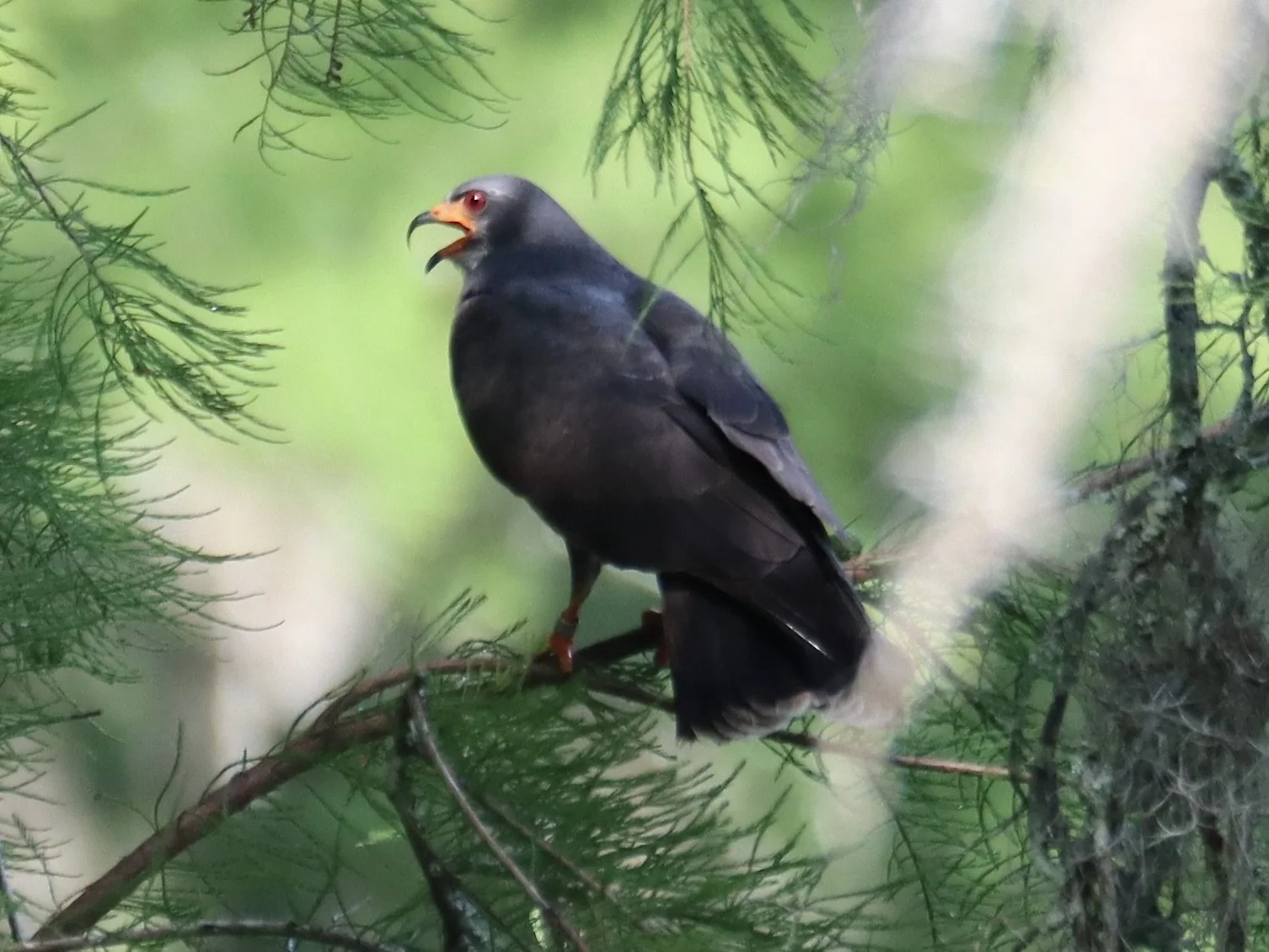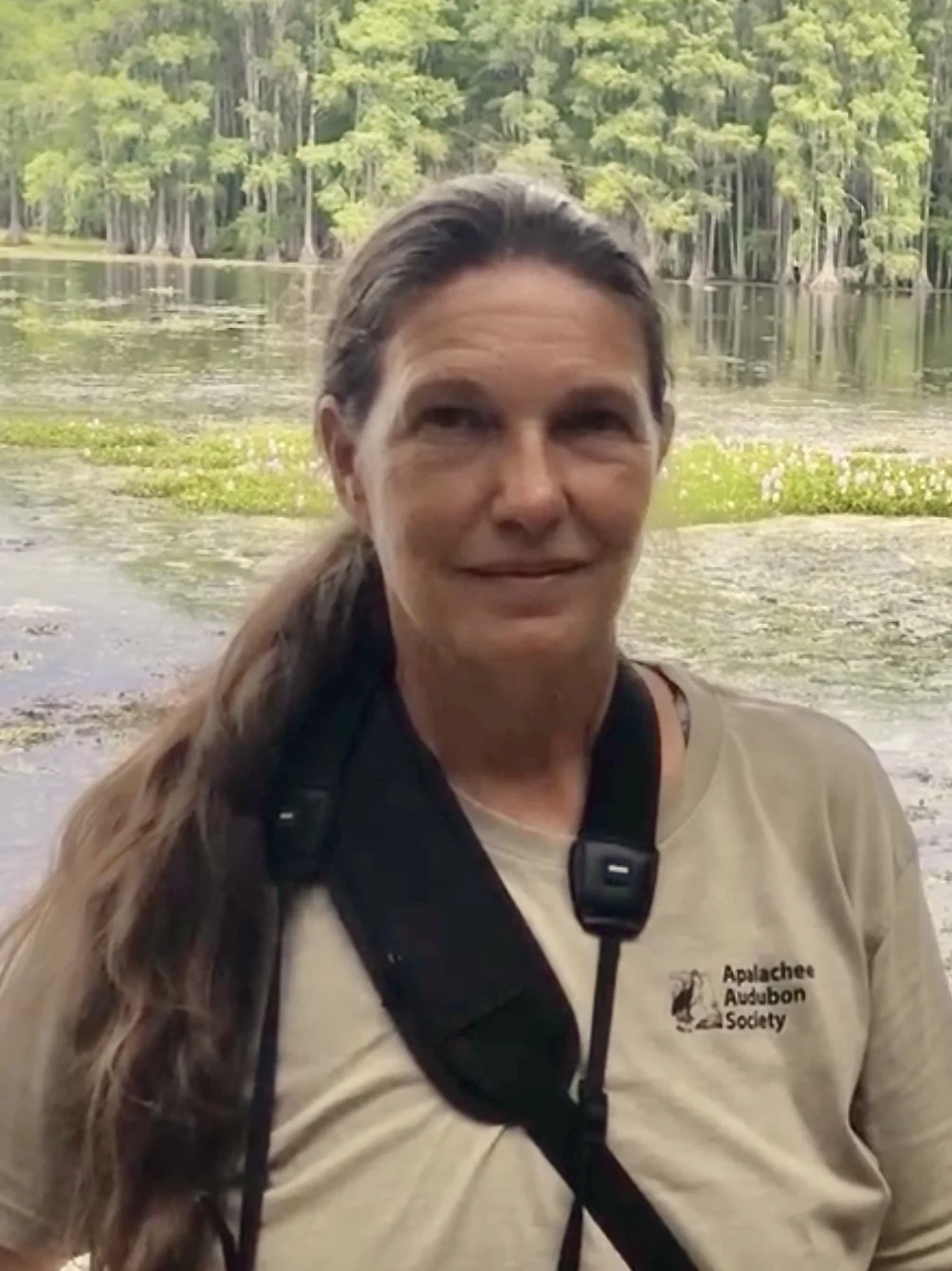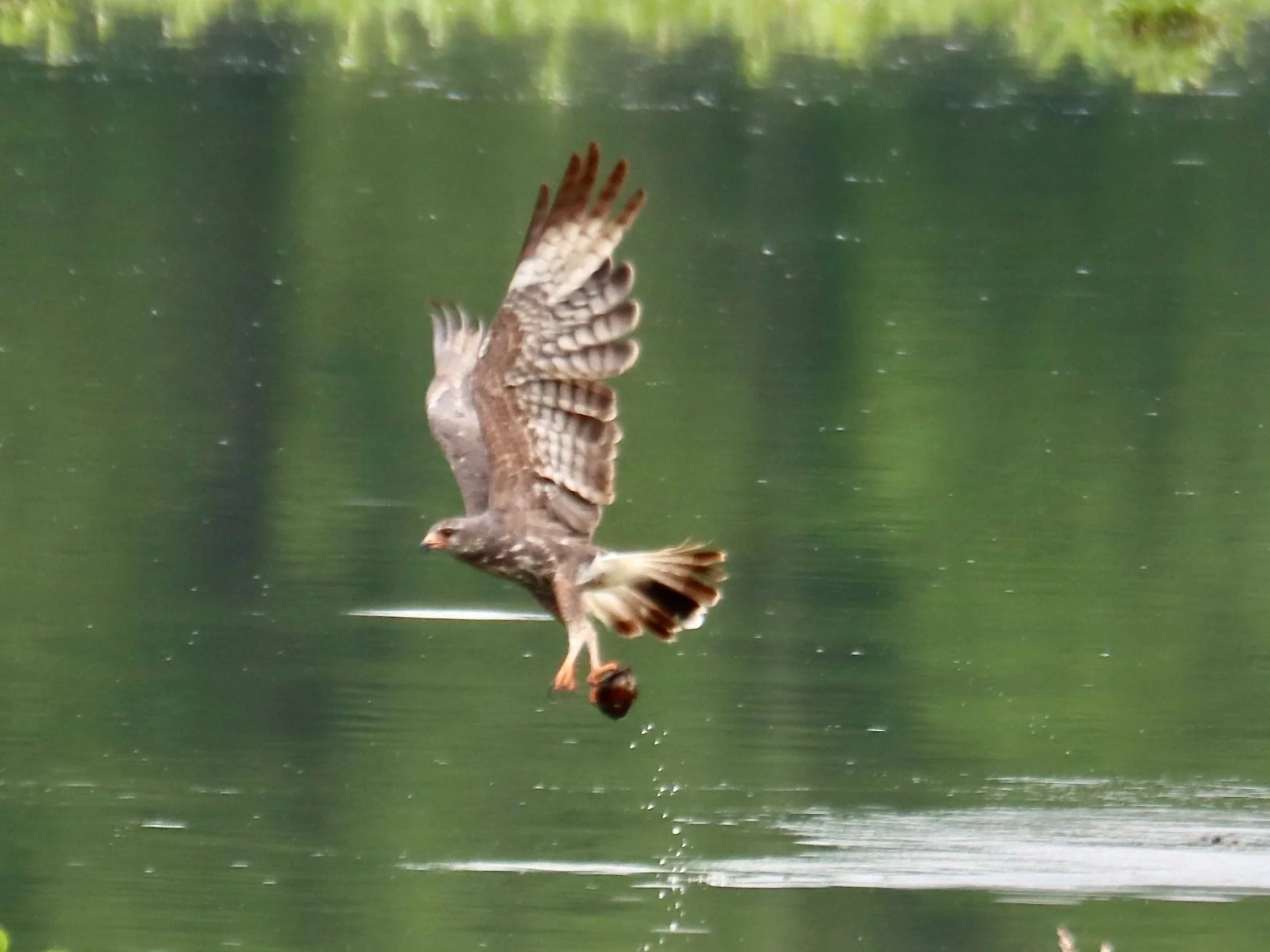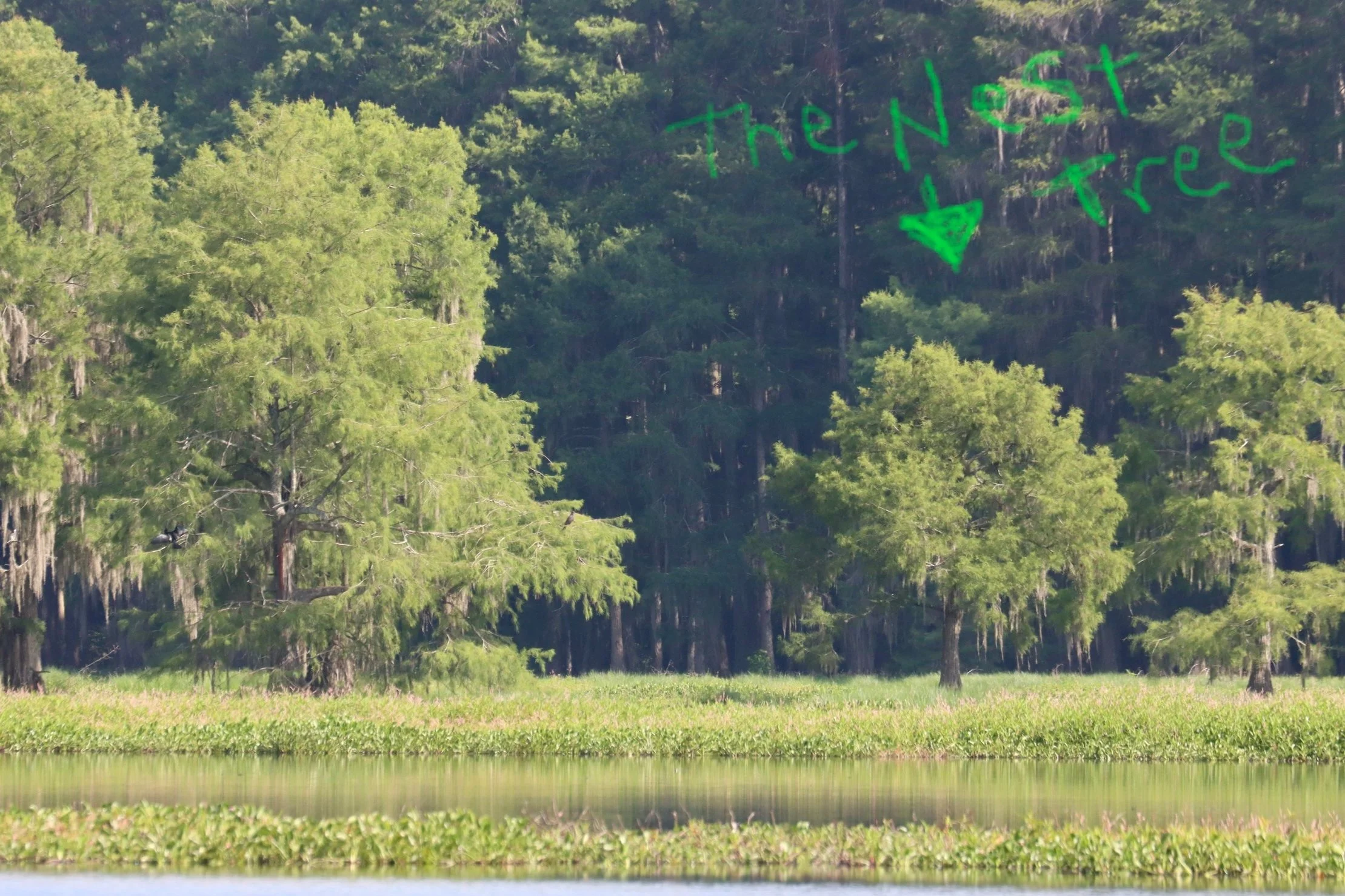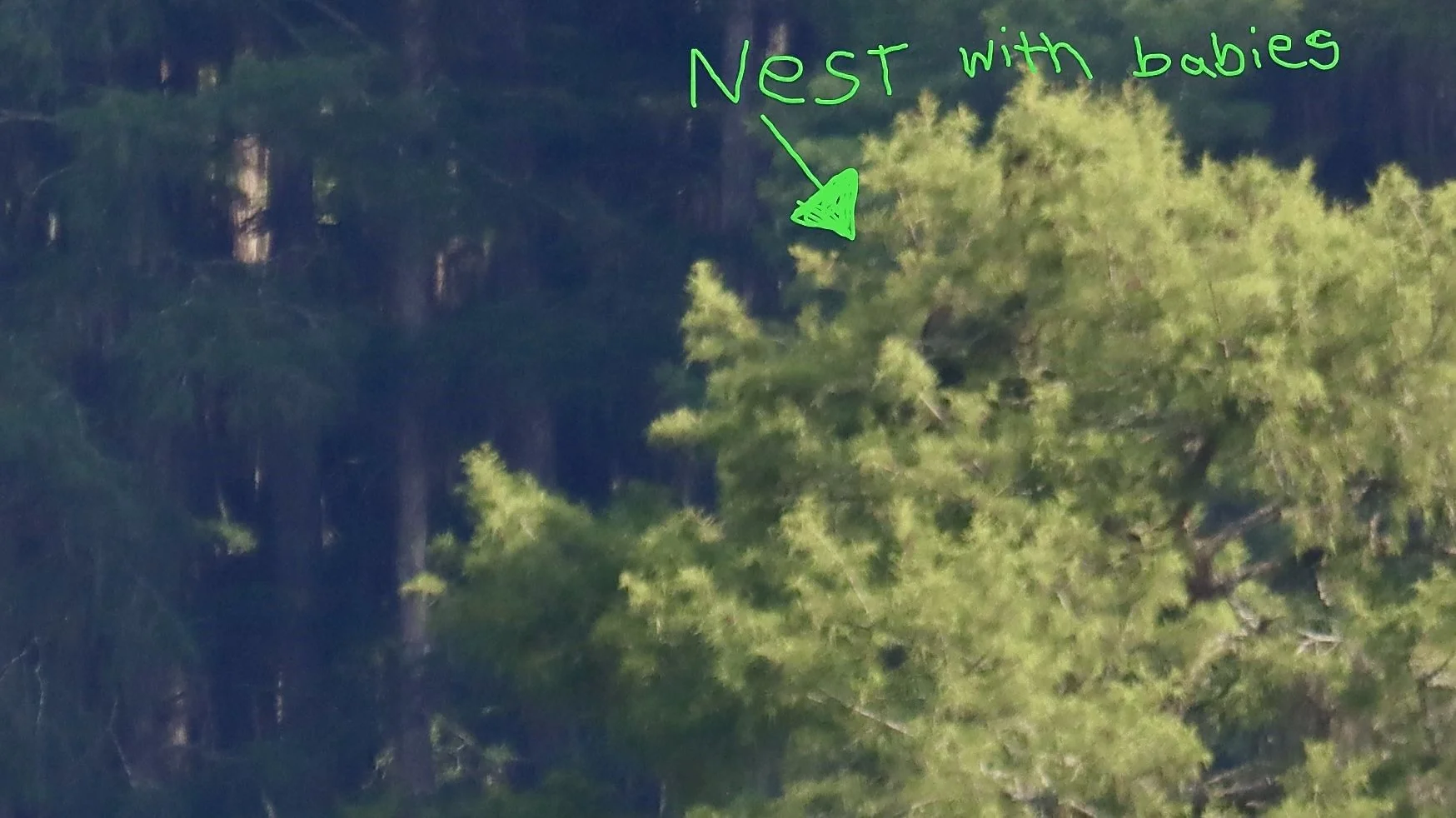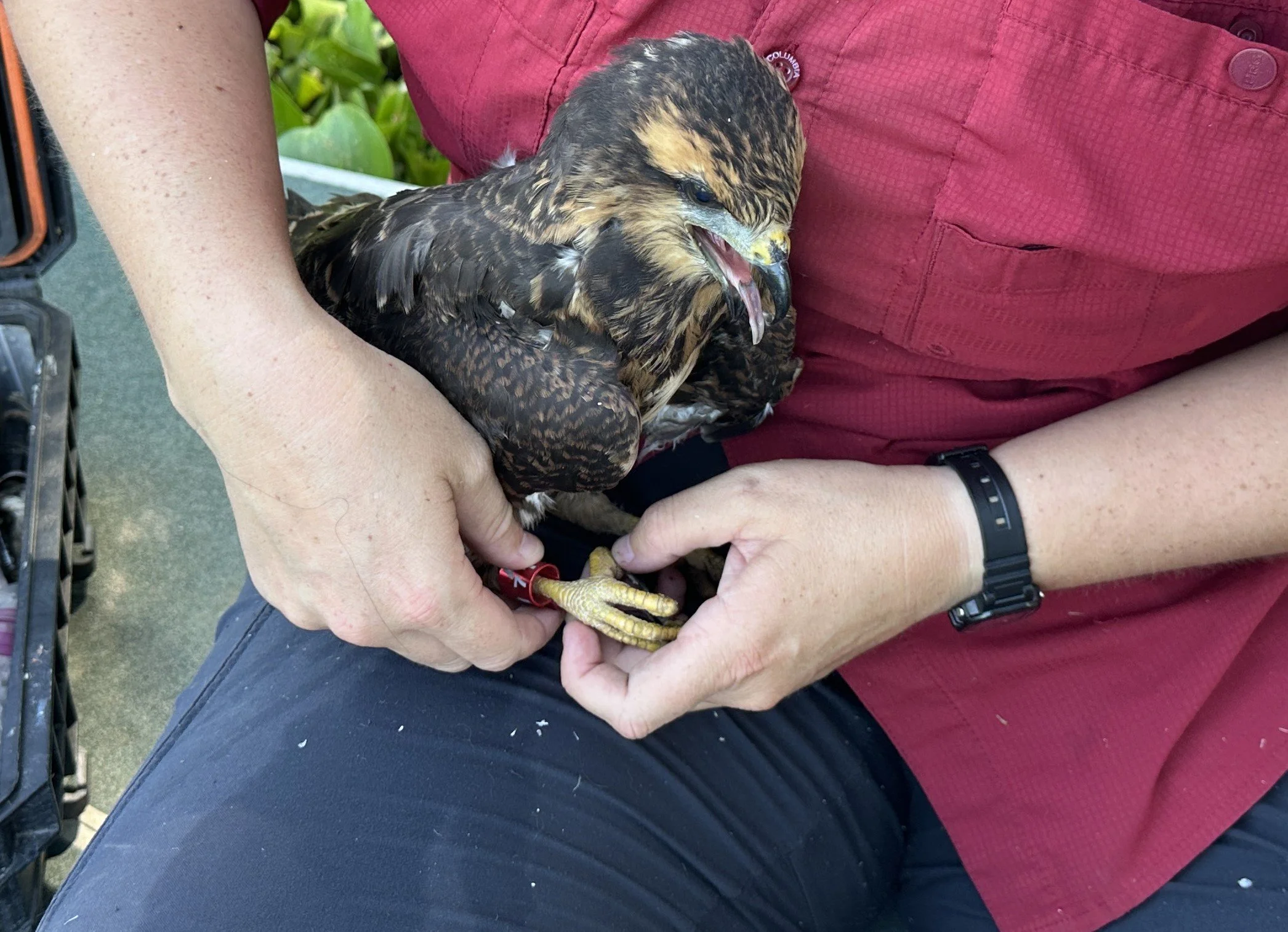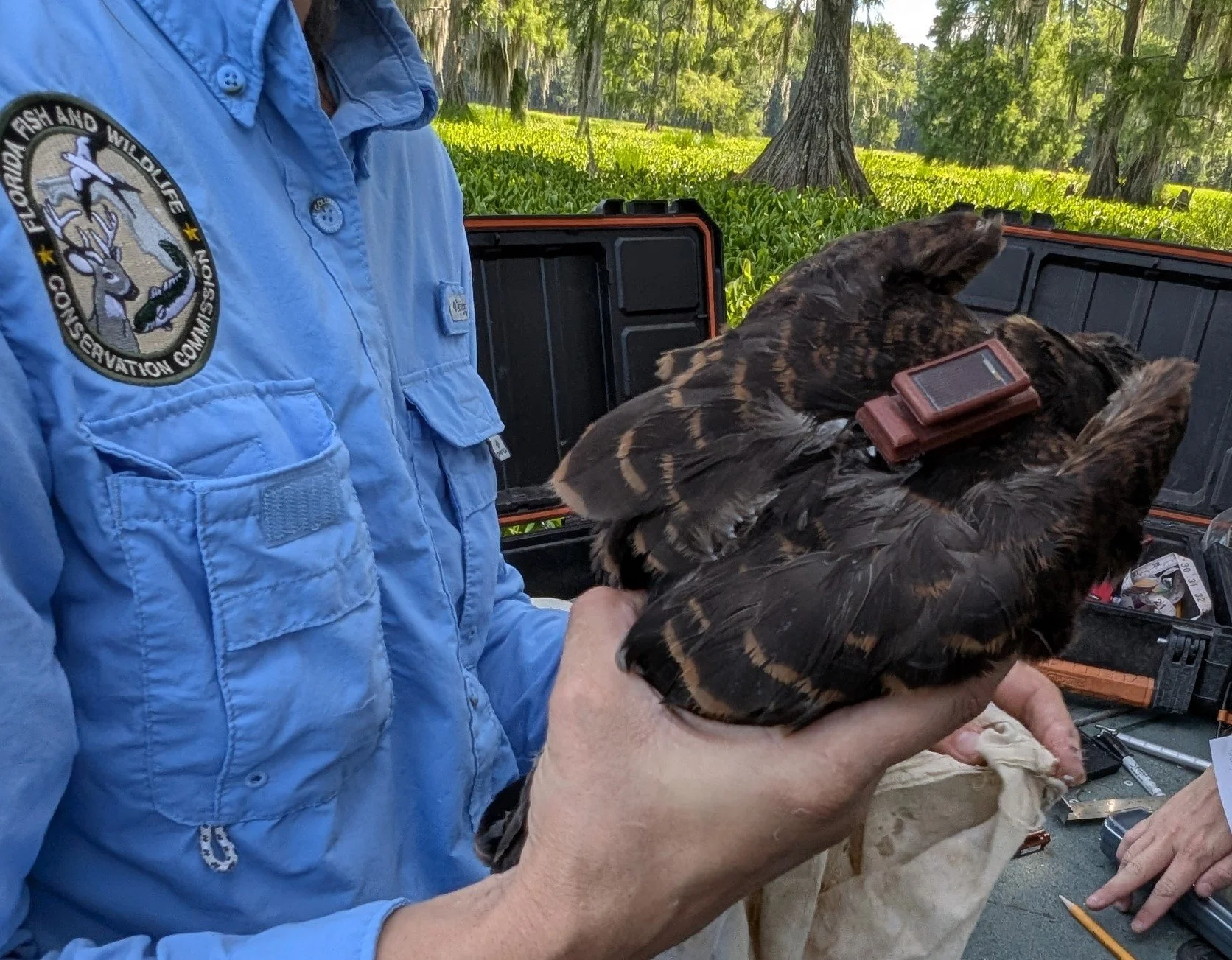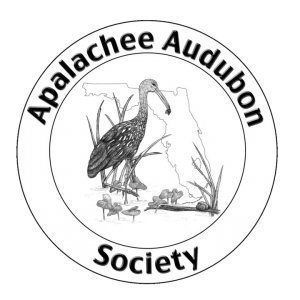UPDATE: August 31, 2025
Juli deGrummond at Lake Munson
As you may recall, at the time of my last writing the first nest, which contained three baby snail kites had just fledged and the second nest contained three fuzzy babies. The first nest all three babies were banded and two of them were fitted with tracking devices that would allow their movements to be documented. Shortly after fledging I received a message that one of the fledgling's tracking device was no longer responding. The biologist indicated that in all likelihood this young bird had not made it but there was a slim chance that it's tracking device had quit working. Of course, I was desperate to see all three fledglings and know that this was incorrect.
During my time observing the fledglings, almost all of the time, two of the banded fledglings were seen together. They would perch on the same perch, sitting side by side eating snails together, flying high in the sky or simply around the lake together. I saw them on the close side of the lake multiple times and heard them "talking" to each other with their juvenile calls. I never could read their bands but one of the times when they were on the close side of the lake, I could have sworn that both birds had the tracking device on their backs. Finally, on August 16th I saw one of the banded fledglings by itself. It was close enough that I could see the band through my scope and get pictures that were legible! Banded Baby A06 was alive and well! This was, in fact, the missing offspring! I contacted FWC and let them know and they informed me that the tracking device had, in fact, picked back up and begun working again. They commented that it was odd how similar their flight paths were for the two birds with tracking units, but it made perfect sense to me since the two I most frequently saw hung around together. The day I saw A06 and got his number, he then went and perched with a younger sibling from nest number two. They definitely seemed to be purposely associating with one another. The two of them flew out and hunted snails and then each returned to the snag they were perching in together and that is where they were when I left that day.
Unfortunately, the second nest of babies never did get banded so we will soon lose track of them and not have their complete story at any time in the future, but I can say with certainty that three babies did fledge from that nest and two definitely were successful with learning how to hunt for snails and feed themselves.
But Wait—There’s More!
During the time that they were getting ready to fledge the mother worked hard to keep them fed and to defend the territory from any perceived threats. The father moved over to the far West side of the lake where he appeared to be overseeing another nest! When FWC came out to check it out, they indicated that there was definitely a nest and it appeared active. There was a male and a female Snail Kite present. They were unfortunately about a day or maybe two too late on banding the second nest. When they came out they saw that there were two freshly fledged young birds and that the mother was very actively guarding them.
Now, going back to the very beginning of these birds’ Tallahassee story, you may recall that there was a male and a female, and that the female that I first found was not the parent of the first two nests. This extra female was for most of this time the most viewable of the Snail Kites as she hung out on the close side of the lake, often hunting in the water hyacinths right in front of the little viewing dock. In the beginning of July she disappeared for about a week, and then made a few appearances again. After that I did not see her until yesterday (August 24th) at which time I viewed her through a scope sitting on the outside of the nest tree on the far West side of the lake. The male has been busy the past few days coming and going from that tree and I feel pretty sure that the two are feeding a new batch of babies.
On top of this exciting news, the mother bird from the previous two nests appears to be spending time in another nest, and I saw the male bird come to that nest and spend time there with her. It is possible that there are in fact two male birds but during the time he was at the mother bird's new nest tree, there was no male present at the other nest tree on the West side of the lake. Just when I think this story is starting to wrap up it takes another exciting turn! I can't wait to see what happens next!
See more photos—and bird species—in the following eBird Checklists that Juli submitted from Lake Munson.
Original Post: July 9, 2025
Juli deGrummond at Lake Munson
I am always happy when I find a conservation story that helps me feel hopeful about our natural world's future. Here in Tallahassee, we have the beginning of what, I hope, will become an ongoing and uplifting story.
This story started on April 20th, 2025 with a trip to Gil Waters Preserve at Lake Munson, a Leon County park and a favorite birding spot of mine. Over the past few years, I have found many birds at this location, including quite a few rare or unusual birds, for example, a single male Snail Kite in 2024. As non-native, invasive Apple Snails at this location have thrived and covered the lower trunks of the beautiful cypress trees with their pink globs of eggs the local population of another snail specialist with its own past conservation concerns, the Limpkin, became a frequently heard and encountered inhabitant here. In fact, this location has become by far the best spot in our area for viewing Limpkins!
Snail Kite carrying its meal of Apple Snail.
On that fateful day, I found both a male and a female Snail Kite perched near each other. This immediately gave me hope that they could be a pair, potentially a breeding pair. Like most people, I have obligations in my life other than staring endlessly at Snail Kites but I began taking every free moment that I had to go to Lake Munson.
The Mating Tree: That month I was leading a field trip for the Orange County Audubon Society. We spent most of our time in neighboring Franklin County and Wakulla County but on April 25th as we made our way to the Tall Timbers Research Station, we made a stop at Lake Munson. As eight people and I watched with scopes and cameras, we witnessed, photographed, and even videoed the Snail Kites mating! Witnessing this event filled the entire group with excitement and joy. We gleefully named the tree in which this happened in "The Mating Tree". While spending this special time with the Snail Kites and my exuberant group of bird lovers, I also learned something new—the call of a Snail Kite.
I had seen Snail Kites both in Belize and in other parts of Florida. I always found them exotic and fantastic and I can vaguely remember listening to their call on Merlin but it did not strike me the same way it did when I heard it live. In fact, that past listening experience did not make an impact on me at all other than thinking it was not what I would have expected. While my cohorts from Orange County Audubon and I made our way around the edges of the lake I heard what I thought was a goat, and that charming goat-like call turned out to be the female Snail Kite! This discovery got my blood pumping and resulted in me dreaming about making recordings of it in the future.
The Nesting Tree: Two days later I took my mom to Lake Munson to share the Snail Kites with her. As we sat with the scope trained on The Mating Tree, we observed the male Snail Kite building a nest in the exact spot that the birds were seen mating. And thus, The Mating Tree became The Nesting Tree. After that, day after day, anytime I was not at work I was watching the Snail Kites.
Arrow points to the small Pond Cypress where the nest was built.
The female was spending most of her time on the close side of the lake, but the nest and the male were on the far side of the lake. I found this odd and sometimes wondered, “How did the female make it to the other side of the lake without me seeing her go?” I began to suspect that there were three birds. On May 3rd, I FINALLY saw all three birds at the same time. More excitement! Three Snail Kites!
Arrow points to the area of the tree where the nest was located.
Three Chicks: With every new discovery I have been left feeling like an excited kid at Christmas. As my Snail Kite watch continued day after day, I shared the information and did everything I could to get documentation of all the events. A trip via boat in mid-May by biologists from the Florida Fish and Wildlife Conservation Commission (FWC) proved inconclusive, but on May 30th Lara Elmquist from the Snail Kite Project (University of Florida, UFL) in conjunction with FWC and came back with the good news that there were indeed three small chicks in the nest!
Young Snail Kite being banded by Lara Elmquist.
Banded: The furthest north where Snail Kites have been documented breeding is Gainesville, over 150 miles away. Laura indicated that they would need to come back in a few weeks to band them when they were bigger. That event happened on June 23rd. At that time, Lara Elmquist (UFL), Caroline Poli (FWC), Derek Fessell (FWC), and Michael Hill (retired from FWC) made the trip out and all three chicks were banded.
One of the two young Snail Kites that was outfitted with a solar-powered tracking beacon. Photo by Michael Hill.
Tracking Devices: Two of the young Snail Kites were also fitted with tracking devices, locator beacons that are solar-powered and use cellular phone technology. Each bird has it’s own phone number and can be located at any time. Snail Kites are a typically nomadic species. These tracking devices will show the young birds' movements and help provide information that can help with managing and protecting their habitats. The Snail Kite was listed in Florida as an endangered species in 1967, residing primarily in the Everglades. It was estimated that in the early 1940s there were as few as 50 to 100 Snail Kites. Thanks to various agencies and people working together to manage their habitat and protect them they have had many ups and downs but have an overall upward trajectory. In 2021 there was estimated to be 3,171 individuals. The University of Florida is in charge of the main monitoring of Snail Kites. They conduct a series of surveys starting in January to find nests, monitoring them and banding the young. They take that information and work with the USGS and FWC to manage their habitats and put protections in place so that they can continue to succeed. Now our Lake Munson Snail Kite young are banded and adding to that information with their tracking devices in place.
Nest #2: Work keeps me busy Monday, Tuesday, and Wednesday so I was not able to visit the birds on their banding day and the two days that followed. Thursday, June 26 finally rolled around and I headed to the lake as soon as I was able. At this time, I could see two of the young birds which were now moving around in the nest tree and making small flights in the tree but still not leaving it. The third young bird was nowhere to be seen. The female (mother) bird continued to bring food to the two remaining babies. The male bird was sitting in a spare nest he made in a tree nearby. He remained there the whole time I was there. The next day, Friday, June 27, I was unable to find any of the young birds. The female was visiting lots of her usual perches and feeding only herself that I could see. Meanwhile, the male remained hanging out in his spare nest.
The next day, Saturday June 28th, two of the young birds, now fledglings, were flying around and awkwardly landing in various spots in the vicinity of their nest tree. The male continued to sit on the spare nest. The female collected a snail and went to one of her favorite perches to shuck the snail from its shell. While she was doing this the male finally came off the spare nest and went and grabbed some new nesting material.
Nest #2 Surprise: Before he could return to the nest to add the new nesting material the female flew into the nest with her shucked snail in her beak. When she entered, I could see with my scope just barely in the nest as a tiny little head came up wobbling and bobbing reaching for the mother bird’s goodie, and then a second little bobbling head popped up! At the time this is being written, July 7, I have seen three fuzzy babies in the nest! As amazing as it seems, this pair worked together to care for their three fledglings as they prepared to move into a different stage of life, while also re-nesting and incubating this new batch.
As we battle to prevent the loss of the planet's biodiversity it is very easy to feel we are fighting a losing battle. This one is a story of hope and small successes that hopefully will continue to pave the way for more successes. So, I encourage you all to see hope, appreciate the success that have come with our system's help. So come to Lake Munson and let's go watch a flying Snail Kite!
Snail Kite perched in a cypress tree at Lake Munson.
See more photos—and bird species—in the following eBird Checklists that Juli submitted from Lake Munson.
